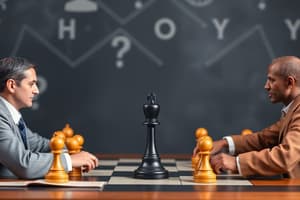Podcast
Questions and Answers
What is an example of a scenario where an agent needs to minimize energy consumption while maximizing task completion?
What is an example of a scenario where an agent needs to minimize energy consumption while maximizing task completion?
- A marketplace where businesses compete and cooperate
- A robot completing a task (correct)
- A poker game with incomplete information
- Financial markets where stock prices change
What is the term for a repeated game where agents choose to cooperate or defect?
What is the term for a repeated game where agents choose to cooperate or defect?
- Partial Observability
- Mixed Behavior
- Iterated Prisoner's Dilemma (correct)
- Large State Space
What is the outcome when both agents cooperate in the Iterated Prisoner's Dilemma?
What is the outcome when both agents cooperate in the Iterated Prisoner's Dilemma?
- No outcome
- Mutual benefit (correct)
- One agent benefits, the other loses
- Mutual defect
What is an example of a scenario with partial observability?
What is an example of a scenario with partial observability?
What is the term for an environment that changes over time?
What is the term for an environment that changes over time?
What is an example of a game with a large state space?
What is an example of a game with a large state space?
What is the term for an algorithm that minimizes regret by considering counterfactual scenarios?
What is the term for an algorithm that minimizes regret by considering counterfactual scenarios?
What is the goal of an agent exhibiting mixed behavior?
What is the goal of an agent exhibiting mixed behavior?
What is a situation where no agent can benefit by changing its strategy while the others keep theirs unchanged?
What is a situation where no agent can benefit by changing its strategy while the others keep theirs unchanged?
What type of game is represented by a game tree, showing the sequential nature of decisions and information available at each decision point?
What type of game is represented by a game tree, showing the sequential nature of decisions and information available at each decision point?
What is an allocation where no agent can be made better off without making another worse off?
What is an allocation where no agent can be made better off without making another worse off?
What type of strategy involves agents aiming to maximize their individual rewards, often at the expense of others?
What type of strategy involves agents aiming to maximize their individual rewards, often at the expense of others?
What is an example of a Cooperative Strategy?
What is an example of a Cooperative Strategy?
What involves optimizing multiple objectives simultaneously, often requiring trade-offs between competing goals?
What involves optimizing multiple objectives simultaneously, often requiring trade-offs between competing goals?
What type of strategy involves agents exhibiting both competitive and cooperative behaviors?
What type of strategy involves agents exhibiting both competitive and cooperative behaviors?
What is an example of a Mixed Strategy?
What is an example of a Mixed Strategy?
What is the main purpose of the Deep CFR algorithm?
What is the main purpose of the Deep CFR algorithm?
What is the main advantage of using opponent modeling in competitive games?
What is the main advantage of using opponent modeling in competitive games?
What is the main goal of centralized training and decentralized execution?
What is the main goal of centralized training and decentralized execution?
What is the main purpose of evolutionary algorithms in mixed behavior?
What is the main purpose of evolutionary algorithms in mixed behavior?
What is the main benefit of using psychology in cooperative behavior?
What is the main benefit of using psychology in cooperative behavior?
What is the main purpose of communication in cooperative behavior?
What is the main purpose of communication in cooperative behavior?
What is the main goal of the CFR algorithm?
What is the main goal of the CFR algorithm?
What is the main advantage of using Deep CFR over traditional CFR?
What is the main advantage of using Deep CFR over traditional CFR?
What is the primary goal of multi-agent reinforcement learning in environments like autonomous vehicles or games?
What is the primary goal of multi-agent reinforcement learning in environments like autonomous vehicles or games?
In the context of multi-agent reinforcement learning, what is a major challenge due to the presence of multiple learning agents?
In the context of multi-agent reinforcement learning, what is a major challenge due to the presence of multiple learning agents?
What is the primary focus of StarCraft as a real-time strategy game?
What is the primary focus of StarCraft as a real-time strategy game?
What is the main purpose of the Gym Example: Hide and Seek in the Gym?
What is the main purpose of the Gym Example: Hide and Seek in the Gym?
What is the characteristic of multiplayer environments?
What is the characteristic of multiplayer environments?
Why is it important to understand multi-agent reinforcement learning?
Why is it important to understand multi-agent reinforcement learning?
What is a key aspect of multi-agent interactions in environments like online games?
What is a key aspect of multi-agent interactions in environments like online games?
What is a characteristic of a Nash strategy?
What is a characteristic of a Nash strategy?
What is a characteristic of a Pareto Optimum?
What is a characteristic of a Pareto Optimum?
What is the main challenge in calculating a solution for a game of imperfect information?
What is the main challenge in calculating a solution for a game of imperfect information?
What is a characteristic of the Prisoner’s Dilemma?
What is a characteristic of the Prisoner’s Dilemma?
What is the iterated Prisoner’s Dilemma?
What is the iterated Prisoner’s Dilemma?
What is the name of the algorithm used to calculate a Nash strategy in competitive multi-agent systems?
What is the name of the algorithm used to calculate a Nash strategy in competitive multi-agent systems?
What are two examples of multi-agent card games of imperfect information?
What are two examples of multi-agent card games of imperfect information?
What is the term for a game with a heterogeneous reward function?
What is the term for a game with a heterogeneous reward function?
Flashcards are hidden until you start studying
Study Notes
Multi-Agent Reinforcement Learning
- Multi-agent reinforcement learning involves multiple agents learning and interacting with each other in a dynamic environment.
Key Concepts
- Nash Equilibrium: A situation where no agent can benefit by changing its strategy while others keep theirs unchanged.
- Pareto Efficiency: An allocation where no agent can be made better off without making another worse off.
Stochastic Games and Extensive-Form Games
- Stochastic Games: Games with probabilistic transitions between states, requiring agents to plan over an uncertain future.
- Extensive-Form Games: Represented by a game tree, showing the sequential nature of decisions and information available at each decision point.
- Nodes: Represent states or decision points.
- Edges: Represent actions taken by the agents.
Competitive, Cooperative, and Mixed Strategies
- Competitive Strategies: Agents aim to maximize their individual rewards, often at the expense of others.
- Example: Chess, where each player tries to checkmate the opponent.
- Cooperative Strategies: Agents work together to achieve a common goal.
- Example: Collaborative robotics where robots work together to complete a task.
- Mixed Strategies: Agents may exhibit both competitive and cooperative behaviors.
- Example: Capture the Flag, where team members cooperate within teams and compete against the opposing team.
Competitive Behavior
- Competitive Behavior: Strategies where agents aim to outperform each other, often leading to adversarial relationships.
- Involves actions like bluffing, deception, and counter-strategies.
Cooperative Behavior
- Cooperative Behavior: Strategies where agents coordinate their actions to achieve a common objective.
- Involves sharing information, planning joint actions, and aligning goals.
Mixed Behavior
- Mixed Behavior: Agents exhibit both competitive and cooperative strategies, depending on the context and their objectives.
- Example: A marketplace where businesses compete for customers but may cooperate in industry standards.
Iterated Prisoner's Dilemma
- Iterated Prisoner's Dilemma: A repeated game where agents choose to cooperate or defect, illustrating the tension between individual rationality and collective benefit.
- Cooperation: Leads to mutual benefit.
- Defection: Leads to individual benefit at the cost of the other.
Challenges
- Partial Observability: Agents have incomplete information about the environment or other agents, making it difficult to make optimal decisions.
- Nonstationary Environments: The environment changes over time, which can alter the strategies and behaviors that are effective.
- Large State Space: The complexity of the state space makes learning and planning computationally intensive and challenging.
Multi-Agent Reinforcement Learning Agents
- Competitive Behavior:
- Counterfactual Regret Minimization (CFR): An algorithm for decision-making in games that minimizes regret by considering counterfactual scenarios where different decisions could have been made.
- Deep Counterfactual Regret Minimization (Deep CFR): A variant of CFR that uses deep learning to handle large state and action spaces.
- Cooperative Behavior:
- Centralized Training/Decentralized Execution: Training agents together with shared information but allowing them to act independently during execution.
- Opponent Modeling: Predicting and responding to the actions of other agents to improve strategic decision-making.
- Communication: Developing strategies that enable agents to share information and coordinate their actions effectively.
- Psychology: Understanding the mental models and strategies of other agents to enhance cooperation and predict behavior.
Evolutionary Algorithms
- Evolutionary Algorithms: Optimization algorithms inspired by natural selection, used to evolve agent strategies over time.
Multi-Agent Environments
- Multi-Agent Environments: Environments where multiple agents interact, such as online games or simulated ecosystems.
- StarCraft: A real-time strategy game that involves both competitive and cooperative strategies, requiring complex decision-making and coordination.
Hands-On Example
- Hide and Seek in the Gym Example: A practical implementation of multi-agent hide and seek in the OpenAI Gym environment, illustrating cooperative behaviors and how agents can learn to hide and seek effectively through MARL.
Studying That Suits You
Use AI to generate personalized quizzes and flashcards to suit your learning preferences.




